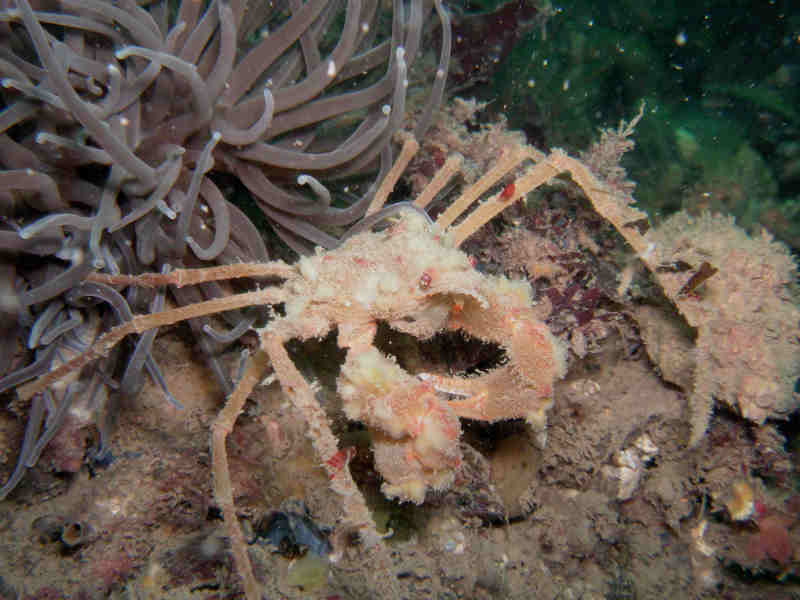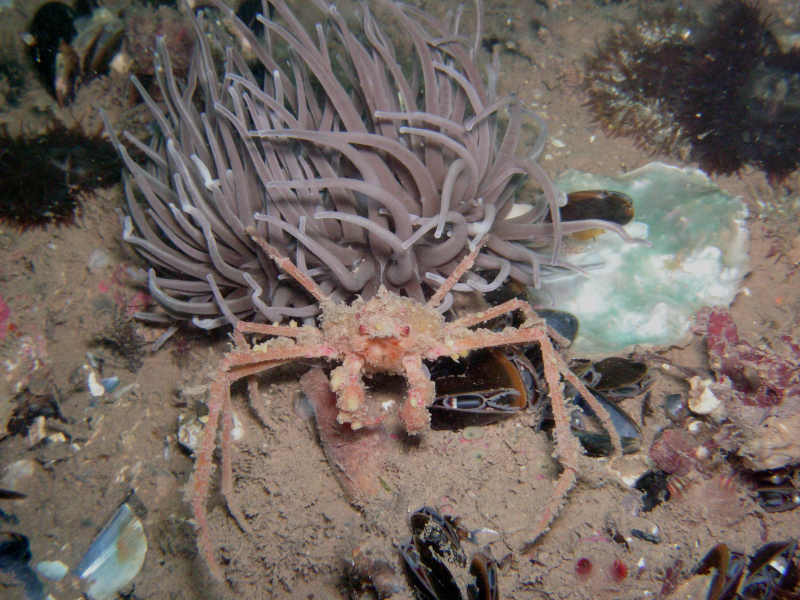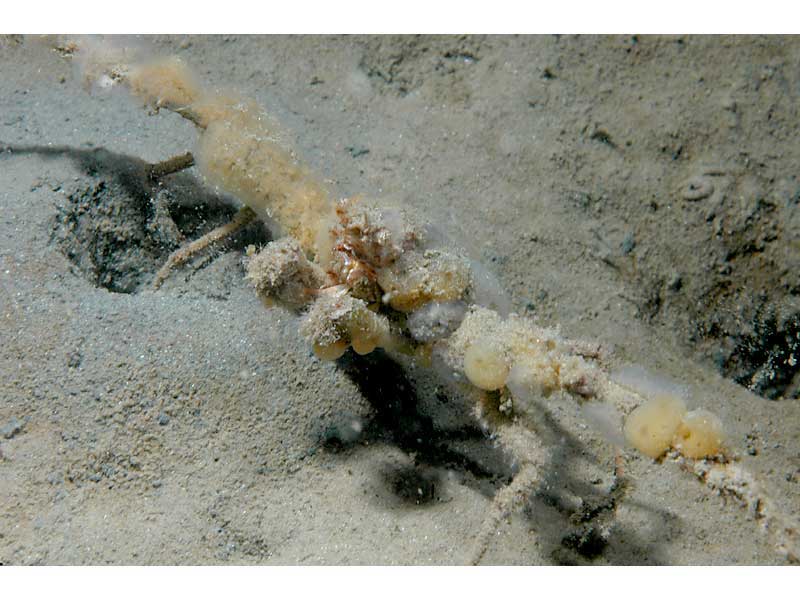Scorpion spider crab (Inachus dorsettensis)
Distribution data supplied by the Ocean Biodiversity Information System (OBIS). To interrogate UK data visit the NBN Atlas.Map Help
| Researched by | Rose Edwards | Refereed by | Admin |
| Authority | (Pennant, 1777) | ||
| Other common names | - | Synonyms | - |
Summary
Description
Recorded distribution in Britain and Ireland
Widely distributed around the British Isles with sparse records along the east coast of England and west coast of Ireland.Global distribution
Recorded in the north east Atlantic from mid Norway southwards to the Spanish Sahara (West Africa), probably the whole of the Mediterranean.Habitat
Inachus dorsettensis occurs in coastal waters from about 4 m to at least 300 m offshore on various substrates such as sand, muddy sand and seaweed-covered rocky beds.Depth range
-Identifying features
- Chelipeds equal in size.
- Carapace triangular, and longer than broad.
- U-shaped cleft separating each half of the rostrum.
- Well developed spines ranging across the anterior part of the carapace.
Additional information
Inachus dorsettensis covers itself in tiny pieces of sponge and sea weed to provide camouflage. It is often found living in the tentacles of the snakelocks anemone (see Ingle, 1996 for further details).Listed by
- none -
Bibliography
Bradshaw, C., Veale, L.O., Hill, A.S. & Brand, A.R., 2002. The role of scallop-dredge disturbance in long-term changes in Irish Sea benthic communities: a re-analysis of an historical dataset. Journal of Sea Research, 47, 161-184. DOI https://doi.org/10.1016/S1385-1101(02)00096-5
Bryant, A.D. & Hartnoll, R.G., 1995. Reproductive investment in two spider crabs with different strategies. Journal of Experimental Marine Biology and Ecology, 188, 261-275.
Crothers, J. & Crothers, M., 1988. A key to the crabs and crab-like animals of British inshore waters. Somerset, England: Field Studies Council. [AIDGAP guide, no. 155.]
Fish, J.D. & Fish, S., 1996. A student's guide to the seashore. Cambridge: Cambridge University Press.
Hall-Spencer, J.M., Froglia, C., Atkinson, R.J.A & Moore, P.G., 1999. The impact of Rapido trawling for scallops, Pecten jacobaeus (L.), on the benthos of the Gulf of Venice. ICES Journal of Marine Science, 56, 111-124
Hartnoll, R.G., Bryant, A.D. & Gould, P., 1993. Size distribution in spider crab populations - spatial and temporal variation. Journal of Crustacean Biology, 13, 647-655.
Hayward, P.J. & Ryland, J.S. (ed.) 1995b. Handbook of the marine fauna of North-West Europe. Oxford: Oxford University Press.
Howson, C.M. & Picton, B.E., 1997. The species directory of the marine fauna and flora of the British Isles and surrounding seas. Belfast: Ulster Museum. [Ulster Museum publication, no. 276.]
Ingle, R., 1997. Crayfishes, lobsters and crabs of Europe. An illustrated guide to common and traded species. London: Chapman and Hall.
Ingle, R.W., 1980. British Crabs. Oxford: British Museum (Natural History), Oxford University Press.
Ingle, R.W., 1996. Shallow-water Crabs, (2nd edn). Shrewsbury: Field Studies Council. [Synopses of the British Fauna, no 25]
JNCC (Joint Nature Conservation Committee), 1999. Marine Environment Resource Mapping And Information Database (MERMAID): Marine Nature Conservation Review Survey Database. [on-line] http://www.jncc.gov.uk/mermaid
Lebour, M.V., 1927. Studies of the Plymouth Brachyura. I. The rearing of crabs in captivity with a description of the larval stages of Inachus dorsettensis, Macropodia longirostris and Maia squinado. Journal of the Marine Biological Association of the United Kingdom, 14, 795-821.
Datasets
Centre for Environmental Data and Recording, 2018. Ulster Museum Marine Surveys of Northern Ireland Coastal Waters. Occurrence dataset https://www.nmni.com/CEDaR/CEDaR-Centre-for-Environmental-Data-and-Recording.aspx accessed via NBNAtlas.org on 2018-09-25.
Environmental Records Information Centre North East, 2018. ERIC NE Combined dataset to 2017. Occurrence dataset: http://www.ericnortheast.org.ukl accessed via NBNAtlas.org on 2018-09-38
Manx Biological Recording Partnership, 2022. Isle of Man historical wildlife records 1990 to 1994. Occurrence dataset:https://doi.org/10.15468/aru16v accessed via GBIF.org on 2024-09-27.
National Trust, 2017. National Trust Species Records. Occurrence dataset: https://doi.org/10.15468/opc6g1 accessed via GBIF.org on 2018-10-01.
NBN (National Biodiversity Network) Atlas. Available from: https://www.nbnatlas.org.
OBIS (Ocean Biodiversity Information System), 2024. Global map of species distribution using gridded data. Available from: Ocean Biogeographic Information System. www.iobis.org. Accessed: 2024-12-28
Citation
This review can be cited as:
Last Updated: 01/11/2005






